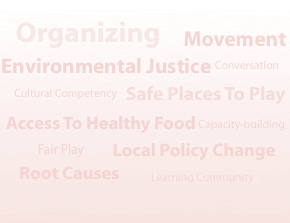Childhood Obesity in Communities of Color: The Problem
We know the numbers: Among African-American girls, 39.2 percent are obese or overweight, compared with 35 percent of Mexican-American girls and 29.5 percent of white girls. Similarly, Among Mexican-American boys, 40.8 percent are obese or overweight, while 30.8 percent of African-American and 31.9 percent of white boys are obese or overweight. The childhood obesity epidemic facing the nation is a byproduct of years of neglect and disinvestment in communities that has undermined our children’s ability to eat well and be physically active. The challenges are greater in communities of color, which typically have less access to healthy, affordable foods and safe places for children and families to play and exercise. As a result, childhood obesity in these communities far outpaces national rates, making it all the more vital that we engage communities in finding solutions to the challenges they face. Studies of other prevention initiatives have shown that increased capacity at the local level has resulted in reduced risks, increased public awareness, and strengthened social and political infrastructures for these initiatives. The purpose of this program is to engage communities of color in changing policies at the community level by building on existing capacity and social networks.
